Infant Icyororo Suffers Severe Bite Wound from Silverback, Dr. Jean Felix Leads Intervention Team
By Gorilla Doctors Staff on Thursday, January 2nd, 2014 in Blog.*** Warning: Blog contains some graphic imagery ***
A violent interaction between lone silverback Rukundo (formerly of Pablo group) and the pair of Isabukuru group silverbacks on December 22nd left Bukima’s infant Imigano dead and Isaro’s 15-month-old infant Icyororo severely wounded. In the field, it often seems that the idiom “when it rains it pours” is especially true. Within a matter of a few days (and in Rwanda alone), our vets conducted a necropsy on deceased dominant silverback Getty, administered medications to wounded silverback Kiki in Susa group, freed infant Sabato from a rope snare in Ugenda group, assessed the resulting injuries from the Isabukuru group/lone silverback interaction and conducted a full medical intervention to treat Icyororo’s severe bite wound.
Here is Dr. Jean Felix’s report of the intervention:
“Dr. Noel and I, along with Volcanoes National Park Veterinary Warden Elisabeth Nyirakaragire and Fossey Fund Karisoke trackers trekked to Isabukuru group shortly after the interaction, prepared to intervene and treat the injured infant. When we arrived to the group, the gorillas were calm for the most part, however Bukima was displaying a lot and very agitated from losing her infant. Adult female Isaro was grooming her injured baby Icyororo, who was sleeping intermittently. 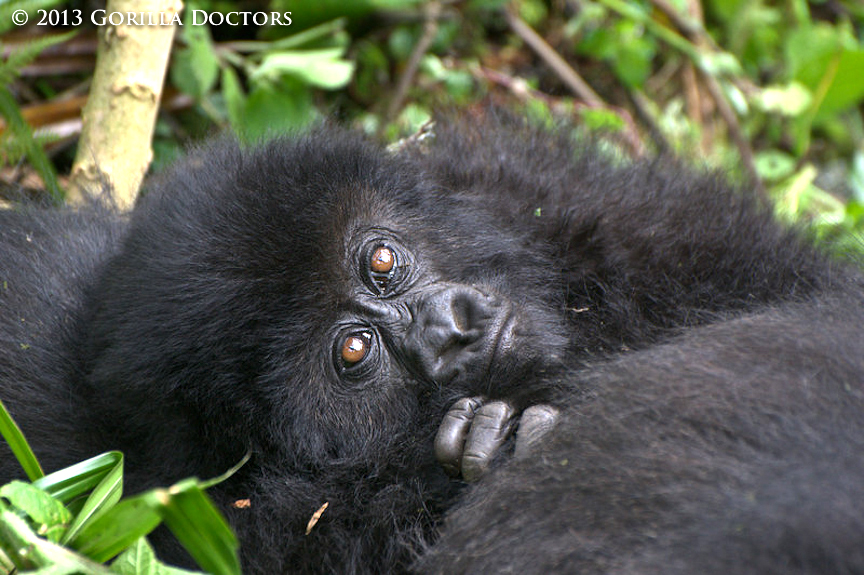 Infant Icyororo in Isabukuru group.
Infant Icyororo in Isabukuru group.
We planned for Dr. Noel and I to dart both mother and infant with anesthesia simultaneously. We waited a long time for a good opportunity that would provide a clear shot of both gorillas. It was easier for Noel to dart the mother, being that she is a large, full grown gorilla with lots of muscle to aim towards… but for Icyororo, I had to be able to hit his small thigh with a short needle while the mother was protectively cradling her infant. When the pair climbed a tree, we both had a clear shot to fire the dart guns. Surprisingly, Isaro didn’t cry out, but just decided to climb down out of the tree and run towards dominant silverback Isabukuru.
Of course, Isabukuru immediately charged us, barking loudly, and all of the group members lumped together in a defensive position. Isaro and Icyororo joined the other females and infants of the group, but we were preoccupied with facing Isabukuru, who is one of the largest mountain gorilla silverbacks that I treat in Rwanda. Fundi, the Fossey Fund’s Field Coordinator and one of the most experienced trackers, lead the other trackers in facing down Isabukuru and Kubaha. He called upon the second group of trackers saying “ni muze” – “come right now” in Kinyarwanda. Isabukuru and Kubaha continued to display and charge throughout the intervention, but the trackers did a great job of keeping a very intense situation under control so that Dr. Noel and I could treat Icyororo.
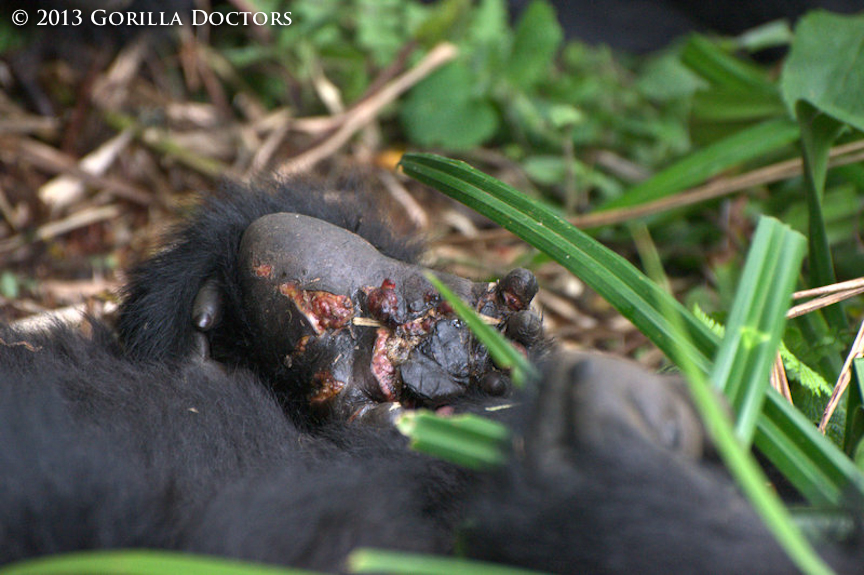 The bite wound on Icyororo’s foot inflicted by lone silverback Rukundo.
The bite wound on Icyororo’s foot inflicted by lone silverback Rukundo.
Once he was under anesthesia, I placed Icyororo on his mother’s abdomen and cleaned his wounds first. Icyororo’s right foot was severely injured by the lone silverback bite and the infant was not able to use the foot for ambulating; he had been moving on the back of his mother constantly.
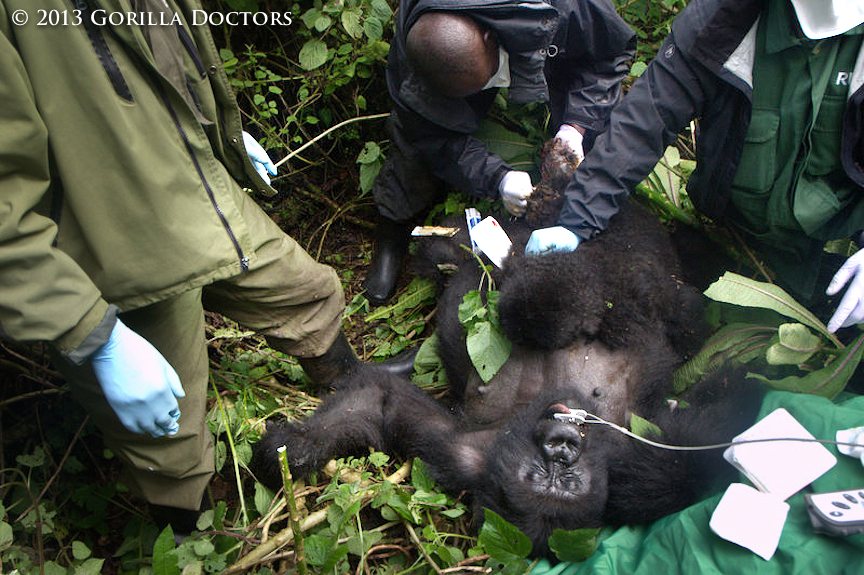 Dr. Noel removes necrotic tissue and cleans the bite wound on Icyororo’s right foot.
Dr. Noel removes necrotic tissue and cleans the bite wound on Icyororo’s right foot.
Two exposed bones had to be cut, as well as all of the necrotic tissue. After injecting lidocaine into the foot and flushing the wounds, I sutured his foot and administered ceftriaxone and ketoprofene on the left and the right thigh. This is a serious wound and will take some time to heal. Gorilla Doctors will continue to reassess his condition and administer additional antibiotics and painkillers when necessary.
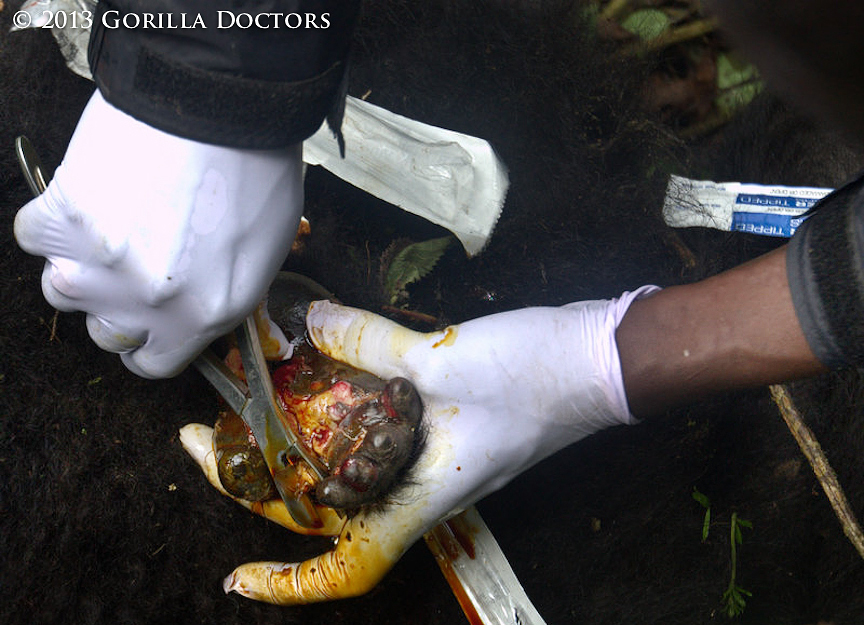 Dr. Jean Felix cuts two exposed bones after injecting a local anesthetic.
Dr. Jean Felix cuts two exposed bones after injecting a local anesthetic.
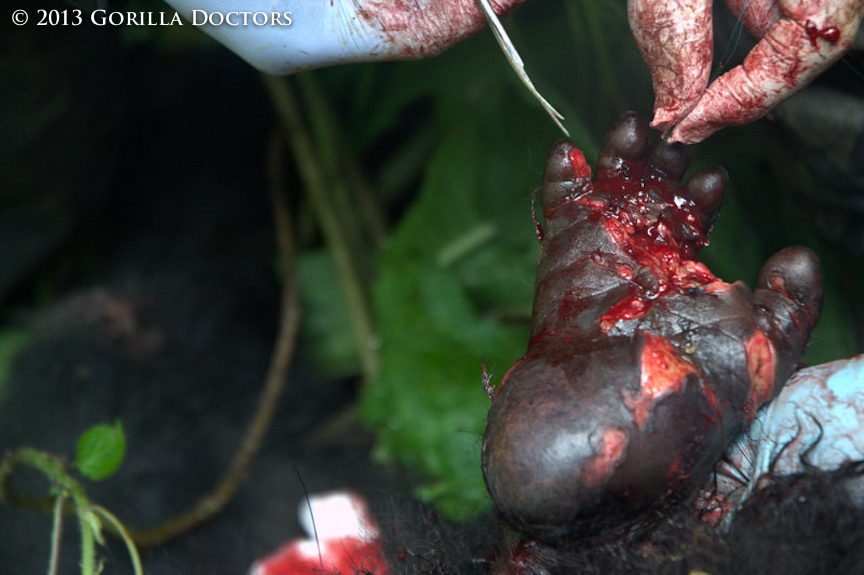 The vets cleaned and sutured the wounds on Icyororo’s foot.
The vets cleaned and sutured the wounds on Icyororo’s foot.
Icyororo woke from the anesthesia on his own and was reasurred to already be on his mother’s stomach. He closed his eyes tightly and clutched his mother for some time after the intervention. We administered antipamezole to Isaro to reverse her anesthesia and observed the pair as they returned to the group.”
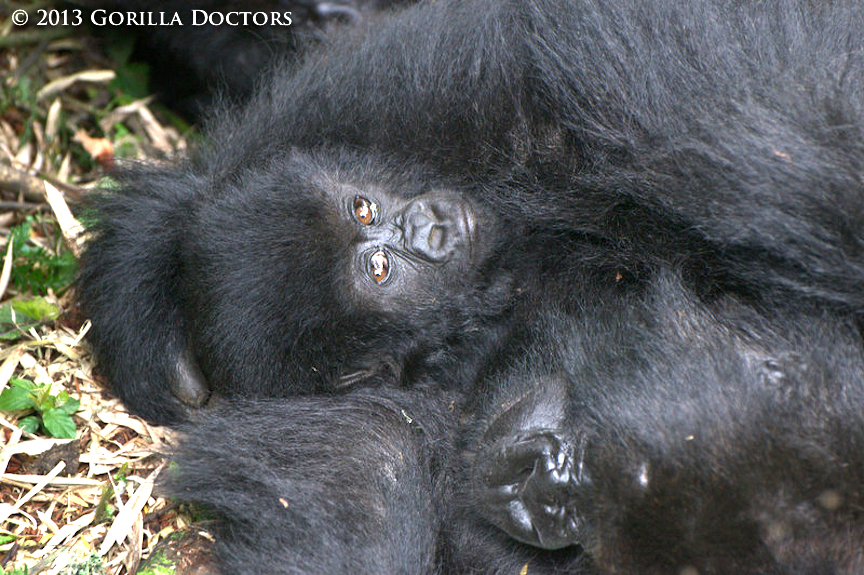 Icyororo, curled up with his mother Isaro.
Icyororo, curled up with his mother Isaro.
This intervention was a perfect example of the critical collaborations between partners in gorilla conservation. Without the expertise and courage of the Fossey Fund Karisoke trackers in facing down charging silverbacks, Gorilla Doctors would not have been able to provide treatment to this infant. Gorilla Doctors would like to thank the Fossey Fund and the Rwanda Development Board for your support and key role in mountain gorilla medical interventions in Rwanda.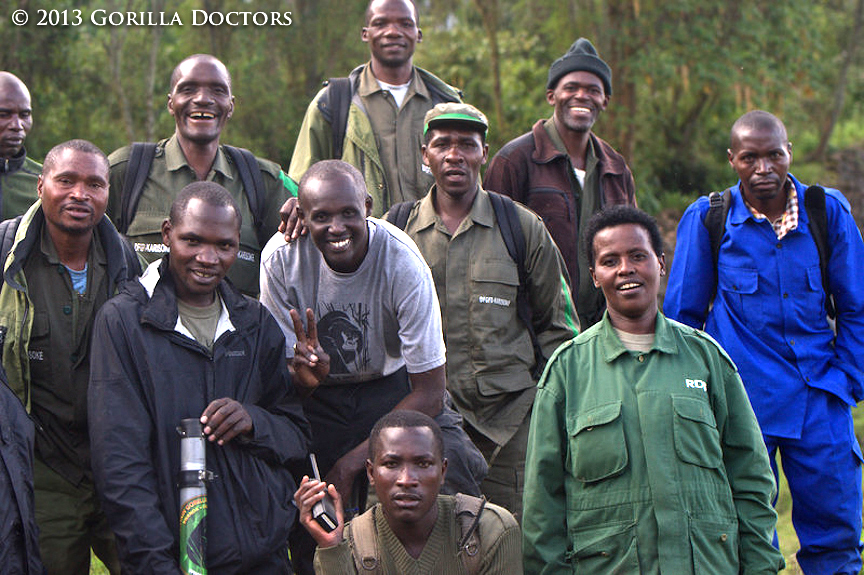 The intervention team: Dr. Jean Felix Kinani (grey shirt, center) with RDB Vet Warden Elisabeth Nyirakaragire (in green), with Fossey Fund Karisoke trackers and porters.
The intervention team: Dr. Jean Felix Kinani (grey shirt, center) with RDB Vet Warden Elisabeth Nyirakaragire (in green), with Fossey Fund Karisoke trackers and porters.
Update: Veronica Vecellio, the Gorilla Program Manager for the Fossey Fund’s Karisoke Research Center reports that silverbacks Isabukuru and Kubaha were very aggressive towards trackers who attempted to observe Icyororo post intervention. The silverbacks screamed and charged the trackers on the 28th, 29th, and 30th, forcing the field team to leave the group. In addition, Vecellio reports that the group is traveling many kilometers every day, and the group members are under evident stress. Stay tuned for the Gorilla Doctors assessment and report on Icyororo’s recovery.
You can follow the Gorilla Doctors health monitoring efforts on our Facebook page, where we post photos and notes from our monthly visits.
Please consider supporting us by making a secure online donation. Every dollar you give goes to directly supporting our gorilla health programs and One Health initiative. Thank you for your generosity.


 Donate
Donate